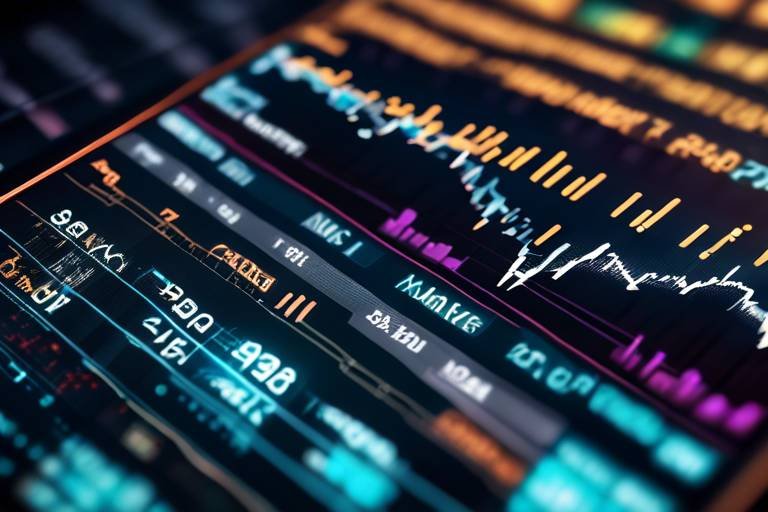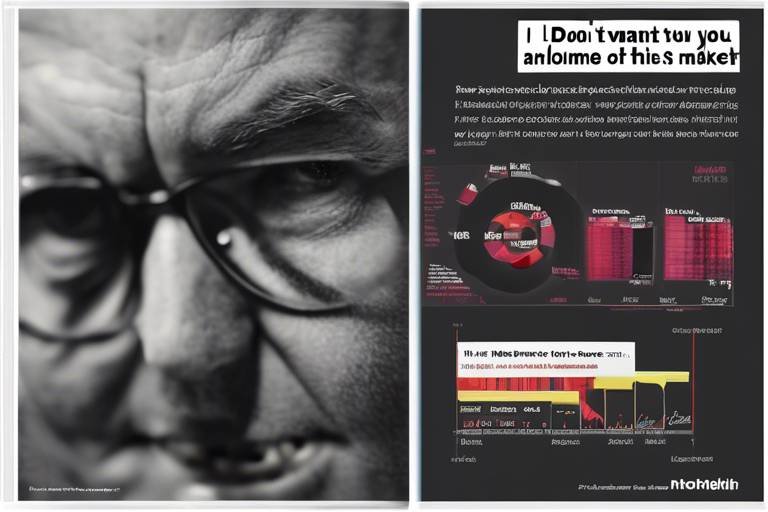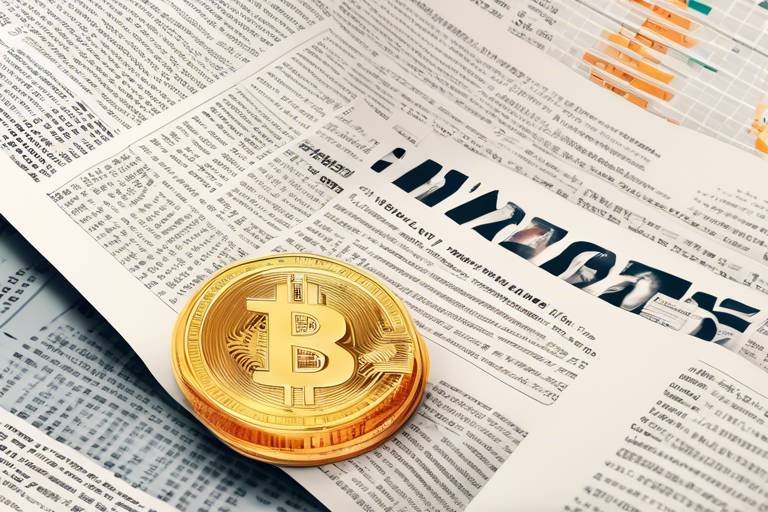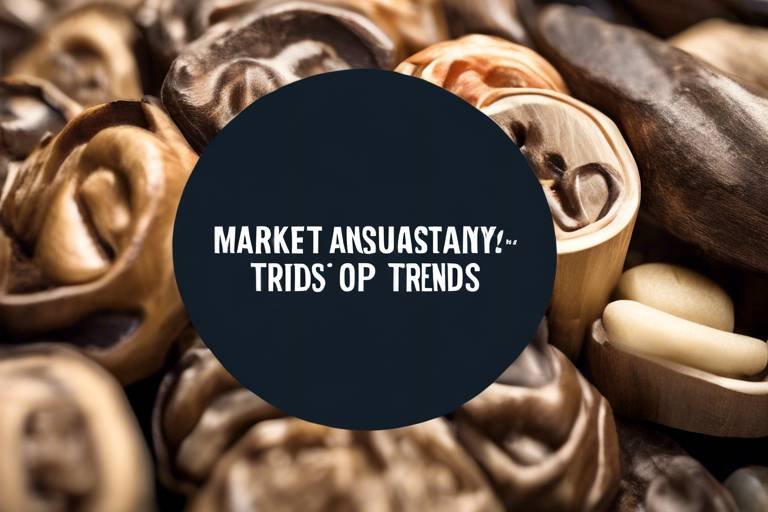Understanding the Dynamics of Market Psychology
The world of trading and investment is not just about numbers and charts; it’s a complex web of human emotions, cognitive biases, and social influences. Understanding market psychology is crucial for anyone looking to navigate the turbulent waters of financial markets. Just like a ship needs a compass to steer through stormy seas, traders need to grasp the psychological factors that drive market behavior. Have you ever wondered why markets seem to soar when everyone is optimistic, only to plummet when fear grips the masses? This phenomenon is not just a coincidence; it’s the result of deep-seated psychological dynamics at play.
At the heart of market psychology lies the interplay between emotions and cognitive processes. Emotions such as fear and greed can lead to irrational trading decisions, while cognitive biases can distort our perception of reality. For instance, when investors are overly optimistic, they may ignore warning signs, leading to disastrous outcomes. Similarly, when panic sets in, even the most rational investors can make hasty decisions that contradict their long-term strategies. This article will delve into these intricate factors, shedding light on how they shape investment decisions and market trends.
Moreover, the social dynamics of trading cannot be overlooked. The concept of herd behavior illustrates how individuals often follow the crowd, sometimes to their detriment. This collective behavior can create market bubbles, where asset prices soar beyond their intrinsic value, only to crash when reality sets in. Understanding these psychological elements not only enhances your trading skills but also equips you to anticipate market movements more effectively. So, buckle up as we explore the fascinating world of market psychology, where emotions and social influences collide to create the ever-changing landscape of financial markets.
- What is market psychology? Market psychology refers to the emotional and cognitive factors that influence the behavior of investors and traders in the financial markets.
- How do emotions affect trading decisions? Emotions like fear and greed can lead to irrational decisions, causing traders to buy or sell based on feelings rather than data.
- What are cognitive biases? Cognitive biases are systematic patterns of deviation from norm or rationality in judgment, affecting how investors perceive information and make decisions.
- What is herd behavior? Herd behavior is the tendency of individuals to mimic the actions of a larger group, often leading to market bubbles or crashes.

The Role of Emotions in Trading
When it comes to trading, emotions play a crucial role that can often lead to irrational decisions. Imagine you’re on a rollercoaster; the highs and lows can be exhilarating, but they can also be quite terrifying. In the world of trading, emotions like fear, greed, and euphoria can create a similar kind of thrill, influencing market movements and individual investment choices.
For instance, when the market is booming, traders often feel an overwhelming sense of euphoria. This can lead to a rush of buying, driven by the fear of missing out (FOMO). It’s akin to being at a party where everyone’s dancing; you feel compelled to join in, even if you don’t know the steps. This emotional high can cloud judgment, causing traders to overlook critical analysis and risk assessments.
Conversely, during market downturns, fear can take over. Traders may panic and sell off their assets, often at a loss, simply to avoid further declines. This reaction is much like a deer caught in headlights—frozen and unable to make rational decisions. Understanding these emotional triggers can empower traders to take a step back and evaluate their strategies more objectively.
Moreover, the influence of greed cannot be underestimated. When traders see their investments rising, the desire for more can lead to reckless behavior. They might ignore warning signs or fail to set stop-loss orders, thinking that the good times will continue indefinitely. This kind of thinking can create a perfect storm for financial disaster.
To combat these emotional influences, traders can adopt several strategies:
- Set clear goals: Establish specific financial targets and stick to them.
- Develop a trading plan: A well-thought-out plan can serve as a roadmap, helping to mitigate emotional decision-making.
- Practice mindfulness: Techniques such as meditation can help traders remain calm and focused, reducing the impact of emotional fluctuations.
Ultimately, recognizing the role emotions play in trading is the first step toward becoming a more disciplined investor. By understanding how feelings can skew perceptions and lead to impulsive actions, traders can learn to navigate the emotional rollercoaster of the market more effectively. It’s all about finding that balance between instinct and analysis, much like a tightrope walker who must maintain equilibrium to avoid falling.
- How do emotions affect trading decisions? Emotions can lead to irrational behavior, causing traders to make impulsive decisions based on fear, greed, or euphoria.
- What strategies can help manage emotions in trading? Setting clear goals, developing a trading plan, and practicing mindfulness are effective ways to manage emotional influences.
- Why is it important to recognize emotional triggers in trading? Recognizing emotional triggers allows traders to make more informed decisions and avoid common pitfalls associated with emotional trading.

Cognitive Biases and Their Effects
Cognitive biases are like invisible glasses through which investors view the market, often distorting reality and leading to poor decision-making. These biases can cause individuals to misinterpret information, leading to **irrational decisions** that deviate from sound investment strategies. For instance, when investors are overly confident in their predictions, they may ignore critical data that contradicts their beliefs. This can be particularly dangerous in volatile markets where emotions run high and the stakes are even higher.
One of the most common cognitive biases is **overconfidence**, which can lead traders to believe they have a greater understanding of the market than they actually do. This inflated self-perception can result in taking excessive risks, as traders may underestimate potential losses. On the other hand, **confirmation bias** can trap investors in a loop of self-reinforcement, where they only seek out information that supports their existing beliefs, disregarding evidence that may suggest a different course of action.
Understanding these biases is crucial for investors who want to enhance their decision-making processes. By recognizing when their judgment might be clouded by cognitive biases, traders can take steps to mitigate their effects. For example, maintaining a trading journal can serve as a powerful tool for self-reflection. In this journal, traders can document their thoughts, decisions, and the outcomes of their trades. This practice not only helps in identifying patterns of bias but also encourages a more disciplined approach to trading.
Furthermore, it’s important to create a **structured decision-making framework** that includes a checklist of factors to consider before making a trade. This framework can help counteract the impulsiveness often driven by emotional responses and cognitive biases. To illustrate this point, consider the following table that outlines some common cognitive biases and their potential effects on trading:
| Cognitive Bias | Description | Effects on Trading |
|---|---|---|
| Overconfidence Bias | Believing one knows more than they do | Underestimating risks, leading to reckless trades |
| Confirmation Bias | Favoring information that supports existing beliefs | Ignoring contrary evidence, leading to poor investment decisions |
| Anchoring Bias | Relying too heavily on the first piece of information encountered | Inflexibility in adjusting strategies based on new data |
By being aware of these biases and their potential impacts, traders can develop a more objective and analytical approach to their investments. It’s crucial to engage in continuous learning and self-assessment to keep these biases in check. Remember, the market is as much about psychology as it is about numbers, and a clear mind can often be the best asset in making sound investment decisions.
- What are cognitive biases? Cognitive biases are systematic patterns of deviation from norm or rationality in judgment, often leading to illogical conclusions.
- How can I identify my cognitive biases? Keeping a trading journal and reflecting on your decisions can help you recognize patterns of biased thinking.
- What strategies can I use to overcome cognitive biases? Implementing a structured decision-making framework and seeking diverse opinions can help mitigate the influence of cognitive biases.

Overconfidence Bias
Overconfidence bias is a psychological phenomenon that can significantly skew a trader's perception of their own abilities and the risks associated with their trading strategies. Imagine you're at a casino, playing poker. You win a few hands and suddenly feel invincible, convinced that you can outsmart the dealer every time. This same feeling can seep into the world of trading, where traders, after experiencing a string of successful trades, may start to believe they possess superior skills or insights. This false sense of security can lead to disastrous decisions, such as taking on excessive risk or ignoring vital market signals.
At its core, overconfidence bias manifests when traders overestimate their knowledge and underestimate the inherent risks in the market. For instance, a trader might feel confident enough to invest heavily in a single stock after reading a few positive articles, ignoring the potential for market volatility or negative news. This bias isn't just a minor hiccup; it can lead to significant financial losses, especially when the market takes an unexpected turn.
To truly grasp the implications of overconfidence bias, it's crucial to recognize its signs. Here are some key indicators:
- Excessive Trading: Overconfident traders often engage in more trades than necessary, believing they can predict market movements with precision.
- Lack of Diversification: They may invest heavily in a few assets, convinced of their superior judgment.
- Ignoring Feedback: Overconfident individuals tend to dismiss advice or data that contradicts their beliefs.
Understanding these signs is the first step toward mitigating the effects of overconfidence bias. But how can traders combat this psychological pitfall? One effective strategy is to maintain a trading journal. By documenting their trades, the reasoning behind them, and the outcomes, traders can gain a clearer perspective on their decision-making processes. This practice encourages reflection and helps identify patterns of overconfidence, allowing for adjustments in strategy.
Moreover, seeking feedback from peers or mentors can provide a reality check. Engaging in discussions with others can reveal blind spots and challenge overinflated self-assessments. Additionally, incorporating data-driven analysis into trading strategies can counteract the emotional impulses that often accompany overconfidence.
Real-life examples of overconfidence bias abound in the trading world. Consider the infamous case of the dot-com bubble in the late 1990s. Many investors, fueled by the rapid rise of technology stocks, became overconfident in their ability to predict continued growth. When the bubble burst, those who had invested heavily in tech stocks faced devastating losses. Analyzing such historical trading failures serves as a valuable lesson for contemporary investors, reminding them of the importance of humility and caution in their trading endeavors.
In conclusion, while confidence is a vital trait for any trader, it's essential to strike a balance. Overconfidence can lead to reckless decisions and significant financial setbacks. By recognizing the signs of overconfidence bias and implementing strategies to mitigate its effects, traders can enhance their decision-making and foster a more disciplined approach to investing.

Strategies to Combat Overconfidence
Overconfidence can be a trader's worst enemy. It's that nagging feeling that you know better than the market, that your gut instinct is infallible, and that you can predict price movements with uncanny accuracy. But, as many seasoned traders will tell you, this mindset can lead to disastrous outcomes. So, how can you combat this psychological pitfall and keep your trading on the right track? Here are some effective strategies.
First and foremost, maintaining a trading journal is one of the most powerful tools at your disposal. By documenting your trades, including the rationale behind each decision and the outcome, you create a tangible record of your thought processes and results. Over time, reviewing this journal can help you identify patterns in your behavior, particularly those driven by overconfidence. You might find that you consistently overestimate your ability to predict market movements during certain market conditions. This self-awareness is crucial for making more rational decisions in the future.
Another essential strategy is to set strict risk management rules. By defining how much capital you are willing to risk on each trade, you establish a safety net that can protect you from the whims of overconfidence. For instance, you might decide that no single trade will risk more than 2% of your total trading capital. This approach forces you to think critically about each trade and its potential risks, rather than getting swept away by the excitement of a promising setup.
Additionally, seeking external feedback can provide a reality check. Engaging with a mentor or joining a trading community can expose you to diverse perspectives and strategies. When you share your thoughts and trades with others, you're more likely to receive constructive criticism that can help you see beyond your own biases. This collaborative approach not only enhances your learning but also keeps you grounded, reminding you that you are not alone in this journey.
Lastly, consider diversifying your investments. When you spread your capital across various assets, you reduce the risk of overconfidence influencing your entire portfolio. This strategy encourages a more analytical approach to trading, as you must evaluate each asset's potential based on its unique fundamentals rather than relying solely on your gut feelings. By diversifying, you also create opportunities for learning from different market segments, which can further refine your trading strategies.
In summary, combating overconfidence requires a multifaceted approach that includes maintaining a trading journal, implementing strict risk management rules, seeking external feedback, and diversifying your investments. By adopting these strategies, you can develop a more disciplined trading mindset that prioritizes rational decision-making over impulsive actions driven by overconfidence.
- What is overconfidence bias? Overconfidence bias is a cognitive bias where individuals overestimate their knowledge, abilities, or control over outcomes, often leading to risky decisions in trading.
- How can I identify overconfidence in my trading? You can identify overconfidence by keeping a trading journal and reviewing past trades to see if you consistently overestimated your predictions or took on excessive risk.
- What are some practical steps to mitigate overconfidence? Practical steps include maintaining a trading journal, setting strict risk management rules, seeking feedback from others, and diversifying your investments.
- Why is risk management important? Risk management is crucial as it helps protect your capital from significant losses, particularly when overconfidence may lead to poor decision-making.

Real-Life Examples
When it comes to understanding the impact of overconfidence bias in trading, history is replete with cautionary tales that serve as poignant reminders for investors. One of the most notable examples is the infamous dot-com bubble of the late 1990s. During this period, many investors were overly confident in the potential of internet-based companies, often ignoring traditional valuation metrics. This overconfidence led to skyrocketing stock prices, with investors throwing caution to the wind in hopes of quick riches. However, when reality set in, many of these companies could not sustain their inflated valuations, leading to a catastrophic market crash in 2000. The aftermath left countless investors with substantial losses, highlighting how overconfidence can cloud judgment and lead to disastrous financial decisions.
Another striking example can be found in the 2008 financial crisis, which was significantly influenced by overconfidence in the housing market. Many investors believed that housing prices would continue to rise indefinitely, leading them to take on excessive risk through subprime mortgages and complex financial products. This overestimation of the market's stability ultimately resulted in a widespread collapse, with millions losing their homes and jobs. Such events underscore the necessity for traders to remain vigilant and grounded in their assessments, rather than succumbing to the allure of unchecked confidence.
In addition to these historical examples, consider the case of an individual trader who experienced a dramatic rise and fall due to overconfidence. Imagine a trader who had a string of successful trades and began to believe they had a "magic touch." This trader, emboldened by past successes, started to increase their position sizes without adequate risk management. The inevitable occurred—a sudden market downturn wiped out a significant portion of their portfolio. This scenario illustrates how overconfidence can lead to reckless decision-making, ultimately resulting in financial ruin.
To further illustrate the impact of overconfidence, a study conducted by behavioral economists found that investors who display high levels of overconfidence are more likely to trade frequently and incur higher transaction costs. This behavior not only diminishes their returns but also amplifies the emotional rollercoaster associated with trading. The findings of this study serve as a stark reminder that while confidence is essential in trading, it must be tempered with a realistic assessment of one’s knowledge and skills.
In conclusion, the lessons learned from these real-life examples are invaluable for traders and investors alike. They emphasize the importance of maintaining humility, conducting thorough research, and implementing risk management strategies. By acknowledging the potential pitfalls of overconfidence, traders can develop a more disciplined approach that ultimately leads to better decision-making and improved outcomes.
- What is market psychology? Market psychology refers to the emotional and cognitive factors that influence investors' decisions and market movements.
- How does fear affect trading? Fear can lead to panic selling, causing prices to plummet as investors rush to exit their positions.
- What is cognitive bias in trading? Cognitive bias refers to systematic patterns of deviation from norm or rationality in judgment, which can lead to poor investment decisions.
- How can I avoid overconfidence bias? Keeping a trading journal, regularly reviewing your trades, and seeking feedback from others can help mitigate overconfidence.
- What is herd behavior? Herd behavior occurs when investors follow the crowd, often leading to market bubbles or crashes.

Confirmation Bias
Confirmation bias is a fascinating psychological phenomenon that can significantly impact trading decisions. It occurs when traders favor information that confirms their pre-existing beliefs or hypotheses, while simultaneously disregarding evidence that contradicts them. This tendency can be likened to wearing blinders; traders may only see what they want to see, which can lead to poor investment decisions and missed opportunities. For instance, if an investor believes a particular stock is a good buy, they might only seek out positive news about that company, ignoring any negative reports or warnings from analysts. This selective perception can create a distorted view of reality, ultimately affecting market behavior.
The implications of confirmation bias are profound. It can lead to a dangerous cycle where traders continuously reinforce their flawed beliefs, making it increasingly difficult to make objective decisions. This bias not only skews individual judgment but can also have ripple effects across the market. When a large number of traders fall prey to confirmation bias, it can create trends based on misinformation rather than solid fundamentals. For example, during the dot-com bubble, many investors ignored critical signs of overvaluation in tech stocks because they were overly focused on the potential for massive gains. This collective bias contributed to a market that spiraled out of control, eventually leading to a significant crash.
To combat confirmation bias, traders must adopt a more balanced approach to information consumption. Here are some strategies to help mitigate its effects:
- Diversify Information Sources: Seek out a variety of news outlets and analysts to gain different perspectives on the market.
- Challenge Your Assumptions: Regularly question your beliefs and consider opposing viewpoints to create a more rounded understanding.
- Engage in Critical Thinking: Analyze data and reports critically, rather than accepting them at face value.
By actively working to recognize and address confirmation bias, traders can enhance their decision-making processes and develop more effective trading strategies. In the end, the goal is to cultivate a mindset that embraces uncertainty and allows for a more comprehensive evaluation of market conditions. Remember, the most successful traders are those who can adapt and remain open to new information, even when it challenges their existing beliefs.
What is confirmation bias? Confirmation bias is the tendency to favor information that confirms one's existing beliefs while ignoring contradictory evidence.
How does confirmation bias affect trading? It can lead traders to make poor decisions by focusing only on supporting information and dismissing critical data.
What are some strategies to overcome confirmation bias? Traders can diversify their information sources, challenge their assumptions, and engage in critical thinking.
Can confirmation bias impact the overall market? Yes, when many traders fall victim to confirmation bias, it can lead to market trends based on misinformation.

The Influence of Social Dynamics
When it comes to trading, the influence of social dynamics cannot be overlooked. It’s fascinating how our decisions can be swayed by the behavior of those around us, creating a ripple effect that impacts the entire market. Imagine standing at a bus stop, and as soon as you see a crowd gathering, you instinctively wonder if you missed something important. This is the essence of social dynamics in trading—it's about how we react to the actions and emotions of others.
One of the most compelling aspects of social dynamics is herd behavior. This phenomenon occurs when individuals in a group act collectively without centralized direction, often leading to irrational market trends. Think of it like a flock of birds; when one bird takes off, the rest follow, often without knowing why. In the financial markets, this can manifest as sudden price spikes or drops, creating bubbles or crashes. Understanding this behavior is crucial for any trader looking to navigate the turbulent waters of market fluctuations.
Moreover, the impact of groupthink can’t be ignored. This is where the desire for harmony or conformity within a group results in irrational or dysfunctional decision-making. Investors might overlook critical information or fail to consider alternative viewpoints because they want to fit in with the group consensus. It’s like being at a dinner party where everyone is raving about a new restaurant; you might agree without considering whether you actually want to go there. In trading, this can lead to missed opportunities or, worse, significant losses.
To better understand these dynamics, let’s take a look at some key factors that contribute to social influences in trading:
| Factor | Description |
|---|---|
| Herd Behavior | The tendency to follow the crowd, leading to potential market bubbles or crashes. |
| Groupthink | A psychological phenomenon where individuals conform to group opinions, leading to poor decision-making. |
| Social Proof | The influence of others' actions on one's own decisions, often seen in trending stocks. |
Understanding these dynamics can empower traders to make more informed decisions. By recognizing the potential pitfalls of herd behavior and groupthink, investors can strive to maintain an independent perspective. It’s essential to critically evaluate information rather than simply going along with the crowd. This means doing your own research, questioning group opinions, and being willing to stand apart when necessary.
In conclusion, social dynamics play a significant role in market psychology. By being aware of how emotions and behaviors of others can influence your trading decisions, you can develop strategies to mitigate these effects. Remember, it’s not just about the numbers; it’s about understanding the human element behind those numbers.
- What is herd behavior in trading?
Herd behavior refers to the tendency of investors to follow the actions of a larger group, often leading to irrational market movements. - How can I avoid groupthink in my investment decisions?
To avoid groupthink, it's crucial to seek out diverse opinions, conduct independent research, and question the consensus within your trading group. - Why is understanding social dynamics important for traders?
Understanding social dynamics helps traders recognize emotional influences and psychological traps, enabling them to make more rational decisions.

Herd Behavior
Herd behavior is a fascinating psychological phenomenon that can significantly impact the financial markets. Imagine a flock of birds suddenly changing direction; it’s not just one bird making the decision, but the entire group follows suit. In trading, this can manifest when investors collectively rush into a stock or asset, often ignoring fundamental analysis and rational decision-making. This behavior can lead to market bubbles, where prices soar far beyond their intrinsic value, only to crash when the herd finally realizes the unsustainable nature of their actions.
One of the key drivers of herd behavior is social proof. When investors see others buying into a particular asset, they may feel compelled to join in, fearing they might miss out on potential profits. This fear of missing out (FOMO) can override logical thinking, causing traders to make impulsive decisions. It’s akin to jumping on a bandwagon without considering where it’s headed. As the market swells with enthusiasm, prices can inflate dramatically, creating an environment ripe for speculation.
However, the implications of herd behavior extend beyond just bubbles. During market downturns, the same psychological triggers can lead to panic selling. When investors witness others fleeing the market, they may instinctively follow, fearing further losses. This creates a vicious cycle, as the mass exodus drives prices down even further, often leading to a crash. To illustrate this, let’s look at a historical example:
| Event | Year | Impact |
|---|---|---|
| Dot-com Bubble Burst | 2000 | Massive sell-off of tech stocks, leading to significant financial losses |
| 2008 Financial Crisis | 2008 | Panic selling in housing and financial markets, triggering a global recession |
Understanding herd behavior is crucial for traders who wish to navigate the complexities of the market. By recognizing the signs of herd mentality, investors can take a step back and evaluate their decisions more critically. For instance, when a stock’s price skyrockets due to hype rather than fundamentals, it’s essential to question whether the price reflects the company’s true value or if it’s merely a product of collective enthusiasm. Developing a disciplined approach to trading, one that relies on thorough analysis rather than emotional responses, can help mitigate the effects of herd behavior.
In conclusion, while herd behavior is a natural human tendency, especially in high-stakes environments like trading, it’s vital for investors to remain vigilant. By fostering independent judgment and sticking to a well-thought-out strategy, traders can avoid the pitfalls that come with following the crowd. After all, in the world of investing, sometimes the best decision is to stand apart from the herd.
- What is herd behavior in trading? Herd behavior refers to the tendency of investors to follow the actions of a larger group, often leading to irrational market movements.
- How can I recognize herd behavior? Look for sudden price spikes or drops in assets that coincide with increased trading volume and social media buzz.
- What are the risks of herd behavior? Following the crowd can lead to significant financial losses, especially during market bubbles and crashes.
- How can I avoid falling into herd behavior? Stick to a solid trading strategy based on research and analysis rather than emotional reactions to market trends.

Groupthink in Investment Decisions
Groupthink is a psychological phenomenon that occurs when the desire for harmony and conformity within a group leads to irrational or dysfunctional decision-making. In the realm of investment, this can be particularly detrimental. Imagine a group of investors gathered around a table, all nodding in agreement about a particular stock without critically analyzing the data. This scenario is a classic example of how groupthink can cloud judgment and lead to poor investment choices.
When individuals prioritize consensus over critical analysis, they often overlook key information that could sway their decisions. Groupthink can manifest in several ways:
- Illusion of Invulnerability: Members believe they are immune to failure, leading to overly optimistic risk assessments.
- Collective Rationalization: Groups dismiss warnings and negative feedback, believing that their shared perspective is the only valid one.
- Pressure to Conform: Individuals may suppress their own opinions to avoid disrupting the group’s harmony.
These factors create a breeding ground for poor investment strategies, as the group often fails to consider alternative viewpoints or dissenting opinions. The consequences can be dire, leading to significant financial losses when the market turns against their collective decision.
To combat groupthink, it’s essential for investors to foster an environment that encourages open dialogue and critical thinking. Here are some strategies that can be employed:
- Encourage Dissent: Create a culture where questioning and challenging the status quo is welcomed. This can be achieved by designating a "devil's advocate" to present opposing viewpoints.
- Diverse Teams: Assemble investment teams with varied backgrounds and perspectives. Diversity can help mitigate the risks of groupthink by introducing different ways of thinking.
- Structured Decision-Making Processes: Implement frameworks for decision-making that require thorough analysis and consideration of alternatives.
By actively addressing groupthink, investors can enhance their decision-making processes, leading to more informed and rational investment choices. The key is to remain vigilant and aware of the psychological dynamics at play within any group setting.
Q1: What is groupthink?
A1: Groupthink is a psychological phenomenon where the desire for harmony in a group results in irrational decision-making. Members suppress dissenting viewpoints to maintain consensus.
Q2: How can groupthink affect investment decisions?
A2: Groupthink can lead investors to overlook critical information, dismiss warnings, and make poor investment choices due to a lack of independent analysis.
Q3: What are some signs of groupthink?
A3: Signs include an illusion of invulnerability, collective rationalization, pressure to conform, and a lack of openness to new ideas.
Q4: How can I prevent groupthink in my investment group?
A4: Encourage dissenting opinions, build diverse teams, and establish structured decision-making processes to ensure all viewpoints are considered.
Frequently Asked Questions
- What is market psychology?
Market psychology refers to the emotional and cognitive factors that influence the behavior of investors and traders. It encompasses how emotions like fear and greed can drive market trends and affect decision-making processes.
- How do emotions impact trading decisions?
Emotions play a significant role in trading, often leading to irrational behavior. For instance, fear can cause traders to sell off assets prematurely, while greed can lead to excessive risk-taking. Understanding these emotional triggers can help traders make more rational choices.
- What are cognitive biases, and how do they affect investors?
Cognitive biases are systematic patterns of deviation from norm or rationality in judgment. They can distort investors' perceptions, leading to poor decision-making. For example, overconfidence can make traders underestimate risks, while confirmation bias can cause them to ignore contrary information.
- What is overconfidence bias, and how can it be mitigated?
Overconfidence bias occurs when traders overestimate their knowledge and underestimate risks. To combat this, traders can implement strategies such as keeping a trading journal to reflect on their decisions and outcomes, helping them stay grounded.
- Can you provide real-life examples of overconfidence in trading?
Yes! Historical trading failures, such as the dot-com bubble, illustrate how overconfidence can lead to significant losses. Investors ignored warning signs and continued to pour money into overvalued stocks, ultimately resulting in a market crash.
- What is confirmation bias, and how can it affect trading?
Confirmation bias is the tendency to favor information that supports existing beliefs while disregarding contradictory evidence. This can lead traders to make poor investment choices based on incomplete or biased information.
- How can traders counteract confirmation bias?
Traders can counteract confirmation bias by actively seeking out diverse viewpoints and challenging their assumptions. Engaging with a variety of sources and considering opposing perspectives can lead to more balanced decision-making.
- What is herd behavior in the context of market psychology?
Herd behavior refers to the tendency of individuals to follow the actions of a larger group, often leading to market bubbles or crashes. It highlights how social dynamics can override individual judgment in trading.
- How does groupthink influence investment decisions?
Groupthink occurs when individuals conform to group opinions, leading to poor decision-making. In trading, this can result in missed opportunities or excessive risk-taking as traders prioritize consensus over independent analysis.



















